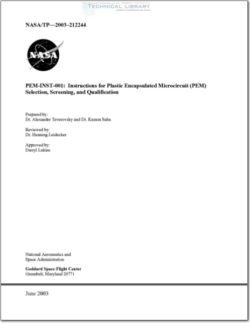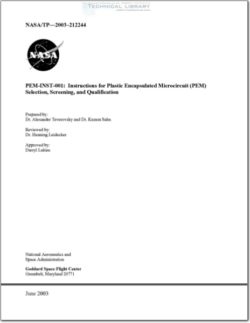NASA-PEM-INST-001

- Version
- 365 Downloads
- 1.42 MB File Size
- 1 File Count
- May 18, 2016 Create Date
- May 18, 2016 Last Updated
Instructions for Plastic Encapsulated Microcircuit (PEM) Selection, Screening, and Qualification

The lessons from the XB-70A program that have been selected for discussion are
only a few of the things that have been learned during the program. These things will
certainly apply to the supersonic tranSport (SST). In some cases they will apply to
any large airplane, and in a few cases they will apply to almost any airplane. The
XB—70 is a very valuable research airplane; there is no other airplane in the world of
similar size that can fly in the same speed environment. Many of its design features
were pushing the state of the art; therefore, both positive and negative results were
obtained, providing validation or correlation of design prediction techniques. It also
provided information on operational factors applicable to a large supersonic aircraft.
The program has been expensive in money, time. and personal sacrifice, but if the
knowledge gained from the XB—70A test program makes it possible to avoid even one
catastrophic SST accident, the program will more than pay for itself.
The XB-70A (fig. 1) is a large, delta—wing, supersonic airplane with dual vertical—
tail surfaces, a movable canard surface with trailing—edge flaps, and a movable nose
ramp to provide acceptable visibility at low Speed and reduced drag at high Speed. The
airplane has retractable landing gear and wing tips that are folded downward to improve
directional stability at transonic and supersonic speeds. It is 189 feet long with a wing
span of 105 feet. The maximum taxi weight is 542, 000 pounds, and the takeoff gross
weight for most flights is approximately 532,000 pounds. The airplane is crewed by
two pilots on experimental or research flights, which have been flown at Speeds up to
Mach 3.0 and altitudes above 7 0. 000 feet.
The flight program began on September 21, 1964, under U. S. Air Force direction
and funding. Since March 29, 1967, a joint NASA-USAF program has been directed
and primarily funded by NASA. Flight support has been provided by the contractors,
North American Rockwell and General Electric, since the beginning of the program.
| File | Action |
|---|---|
| NASA-PEM-INST-001 Instructions for Plastic Encapsulated Microcircuit (PEM) Selection, Screening, and Qualification.pdf | Download |
Comment On This Post